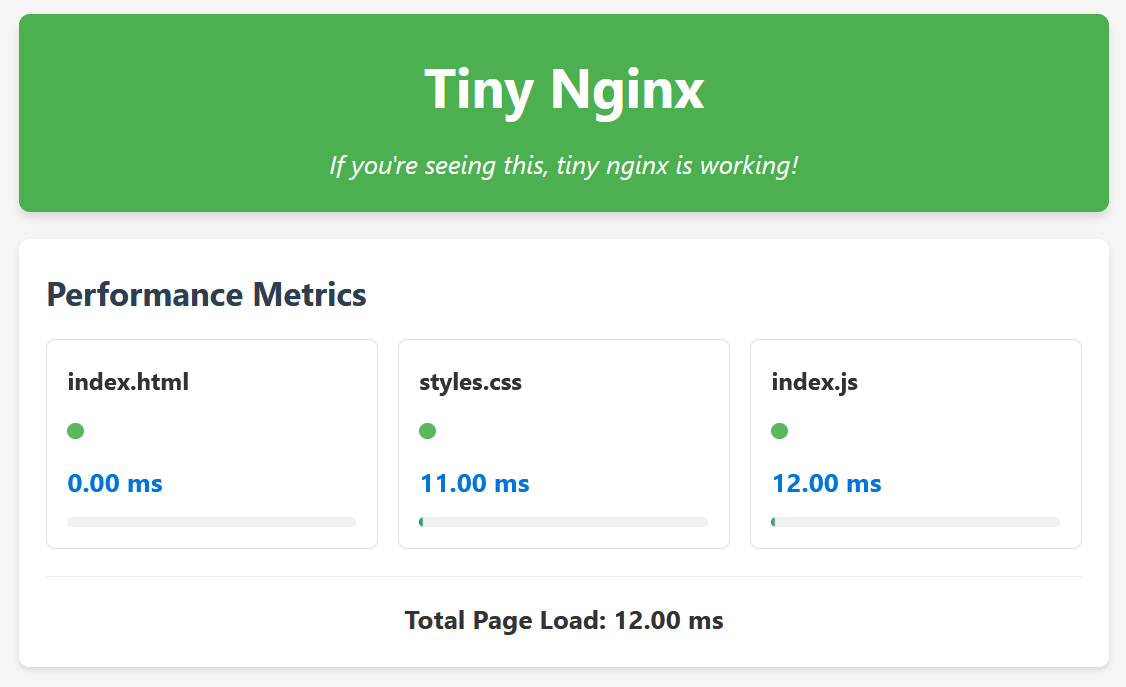A lightweight, non-blocking, event-driven, multi-process HTTP server written in C, inspired by the core architecture of Nginx.

Overview #
tiny-nginx is a minimalistic HTTP server that implements the core architectural patterns that make Nginx powerful and efficient:
- Non-blocking I/O: Uses
epollin level-triggered mode for efficient I/O multiplexing - Event-driven architecture: Handles connections asynchronously to maximize throughput
- Multi-process model: Creates worker processes equal to the number of CPU cores for optimal resource utilization
Features #
- Asynchronous I/O: Non-blocking sockets with epoll event handling
- Efficient worker processes: Automatically spawns workers based on available CPU cores
- CPU affinity: Each worker is bound to a specific CPU core
- Static file serving: Efficiently serves static files from a configured directory
- HTTP protocol support: Basic HTTP/1.1 implementation
- Graceful shutdown: Properly handles termination signals
- MIME type detection: Automatically sets appropriate Content-Type headers
- URL decoding: Properly handles URL-encoded paths
- TCP optimizations: Uses TCP_NODELAY to reduce latency
Architecture #

The server uses a multi-process architecture:
Master Process: Responsible for:
- Initializing the listening socket
- Spawning worker processes
- Managing worker lifecycle
- Handling shutdown signals
Worker Processes: Each worker:
- Is bound to a specific CPU core
- Accepts connections from the shared listening socket
- Handles HTTP requests asynchronously
- Serves static files efficiently using sendfile
Event System: Core of the non-blocking architecture:
- Uses epoll (level-triggered mode) for efficient I/O multiplexing
- Tracks connection states
- Handles events from multiple file descriptors
Building #
Note: This project only works on Linux systems as it relies on Linux-specific features like
epoll.
# Clone the repository
git clone https://github.com/gd-arnold/tiny-nginx.git
cd tiny-nginx
# Build the project
make
Usage #
# Start the server on port 8080
./build/tiny-nginx -p 8080
By default the server serves files from the ./public directory.
Project Structure #
- client.{c,h}: HTTP client connection handling
- dbg.h: Debugging macros
- event.{c,h}: Event system (epoll wrapper)
- main.c: Entry point
- master.{c,h}: Master process implementation
- server.{c,h}: TCP server setup
- worker.{c,h}: Worker process implementation
Implementation Details #
Event Loop #
The core of tiny-nginx is its event loop, which efficiently multiplexes I/O operations:
while (running) {
int nready = es_wait(es);
for (size_t i = 0; i < (size_t)nready; i++) {
EventBase* event_data = (EventBase*) es->events[i].data.ptr;
uint32_t events = es->events[i].events;
switch (event_data->type) {
case SIGNAL_EVENT:
running = false;
break;
case SERVER_EVENT:
accept_client(es, (TCPServer*) event_data);
break;
case CLIENT_EVENT:
if (events & EPOLLIN) {
receive_from_client(es, (HTTPClient*) event_data);
} else if (events & EPOLLOUT) {
send_to_client(es, (HTTPClient*) event_data);
}
break;
}
}
}
HTTP Request Processing #
Each HTTP request follows a state machine approach:
- CLIENT_RECEIVING_REQUEST: Read and parse the HTTP request
- CLIENT_SENDING_HEADERS: Send HTTP response headers
- CLIENT_SENDING_FILE: Send the requested file using sendfile
- CLIENT_CLOSING: Close the connection
File Serving #
The server efficiently serves static files using sendfile() to avoid unnecessary copying between kernel and user space:
ssize_t n = sendfile(client->event.fd, client->file_fd,
&client->file_offset,
client->file_size - client->file_offset);
Limitations #
The server is designed as a learning tool and is NOT meant to be used in production
There are many areas where it can be improved like:
- Client timeout handling (!)
- Detached mode
- Logging
- HTTP keep-alive support
- Configuration file

